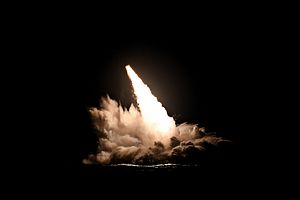The U.S. Navy conducted four scheduled missile test firings of unarmed Trident II (D5) missiles from the Ohio-class nuclear-powered ballistic missile submarine (SSBN), USS Nebraska (SSBN-739), off the coast of Southern California this month.
The first two launches took place on September 4 and the last two on September 6. According to a U.S. Navy press statement, the four test launches were part of a Commander Evaluation Test (CET) with the primary goal of validating performance expectations of the submarine-launched Trident II D5 ballistic missiles (SLBM).
It marked the 176th in the line of successful flights of the Trident II (D5) SLBM. The last test launch of Trident II (D5) took place in May of this year when the USS Rhode Island fired an unarmed SLBM from a submerged position off the coast of Florida as part of a so-called Demonstration and Shakedown Operation (DASO).
The September 2019 flight tests were “conducted on a recurring, scheduled basis to evaluate and ensure the continued reliability and accuracy of the system,” according to the Navy. “The missile tests were not conducted in response to any ongoing world events.”
The Trident II (D5) is a three-stage, solid propellant ballistic missile with a range of about 4,000 nautical miles or around 7,400 kilometers. The SLBM is armed with multiple independently targetable reentry vehicles each carrying a thermonuclear warhead. housing the warhead.
According to the Bulletin of the Atomic Scientists: “The Trident D5s carry three types of warheads: the 100-kiloton W76/Mk-4, the 100-kiloton W76-1/Mk-4A, and the 455-kiloton W88/Mk-5 warhead, the highest-yield ballistic missile warhead in the U.S. arsenal.”
The SLBM was originally designed with a life span to 2024. Yet it recently underwent a life extension that will keep the strategic weapon system operational through the late 2040s. The U.S. Navy at the moment operates 14 Ohio-class SSBNs, each capable of carrying up to 24 Trident II (D-5) SLBMs.
Starting in 2031, the new Columbia-class will slowly begin replacing the Ohio-class fleet as the main leg of the U.S. Navy’s sea-based nuclear deterrent. The lead SSBN of the Columbia-class is expected to be delivered to the U.S. Navy by 2028 and will also carry the Trident II (D-5) SLBM.
“After being delivered in [fiscal year] 2028, the lead boat would undergo substantial testing, with the aim of having it be ready for its first deterrent patrol in 2031,” according to a May 2019 Congressional Research Service (CRS) report.
Total procurement cost for the Columbia-class is estimated at over $100 billion. “The Navy’s FY2020 budget submission estimates the total procurement cost of the 12-ship class at $109.0 billion in then-year dollars,” according to the CRS report.

































